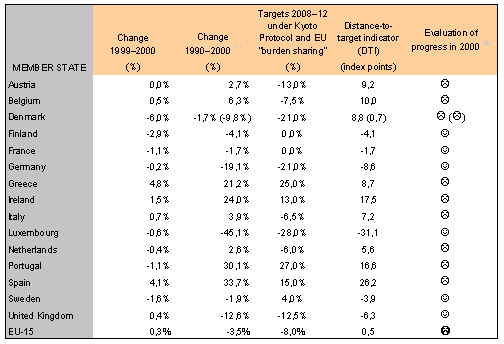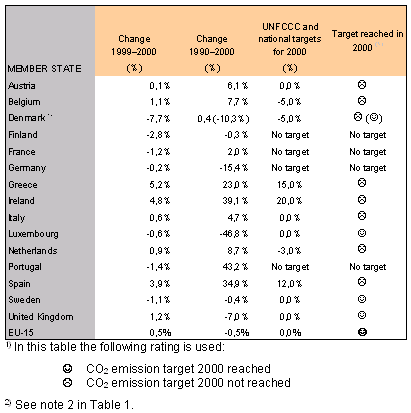NEWS RELEASE
Copenhagen, 29 April 2002
EU
reaches CO2 stabilisation target despite upturn in greenhouse gas
emissions
The European Union has delivered on its long-standing commitment to
stabilise emissions of carbon dioxide (CO2) - the main
"greenhouse" gas responsible for man-made global climate change - at
their 1990 level by 2000, despite an emissions upturn in the final year
of the period.
Total CO2 emissions from the 15 EU Member States were
0.5% lower in 2000 than 10 years earlier, the latest emissions
inventory from the European Environment Agency shows.
Less positive, however, is that EU emissions of CO2 and
other greenhouse gases rose between 1999 and 2000, the most recent year
for which EU-wide data are available. CO2 accounts for
around 80% of the EU's total greenhouse gas emissions.
CO2 emissions taken alone increased by 0.5% in 1999-2000,
while emissions of CO2 and the five other gases controlled
by the Kyoto climate change Protocol together rose by 0.3%.
Under the Kyoto Protocol the EU is required to cut its combined
emissions of the six gases to 8% below their 1990 level by the years
2008-2012.
The latest inventory shows that in 2000 total EU greenhouse gas
emissions stood 3.5% below their 1990 level. In 1999 they had been 3.8%
lower, according to the most recent estimates.
"These figures make clear that in 2000 the EU suffered a slight
reversal in its progress towards achieving its Kyoto target," EEA
Executive Director Domingo Jiménez-Beltrán said. "The situation is now
that the EU is slightly less than half way towards reaching the target,
with just over half of the time gone before the Protocol's first
compliance period starts in 2008."
One of the main reasons for the overall emissions rise from 1999 to
2000 was a 2.4% increase in CO2 emissions from electricity
and heat production, due in part to an expansion of power generation
from fossil fuels, especially coal, in the UK, the EU's second-largest
emitter. Another reason was continued growth in greenhouse gas
emissions in Greece, Spain, Ireland, Italy and Belgium.
The year-2000 figures mean that more than half of the European Union
countries are still heading towards overshooting their agreed share of
the EU's greenhouse gas emissions target by a wide margin. This is the
case for Austria, Belgium, Denmark, Greece, Ireland, Italy, the
Netherlands, Portugal and Spain.
Spain is furthest away from keeping to its share of the EU target:
its emissions in 2000 stood 33.7% higher than a decade earlier, more
than double the 15% increase it is allowed between 1990 and
2008-2012.
At the other end of the scale Germany, the largest EU emitter, has
achieved the greatest emissions cut among the big Member States,
recording a 19.1% decrease over the decade. This is not far off the 21%
reduction from 1990 levels that Germany is required to show by
2008-2012.
Details of EU and Member State emissions are shown in the Annex to
this news release. EEA will publish an analysis of the emission figures
and trends in autumn 2002.
The inventory is available on the EEA's web site at http://reports.eea.europa.eu/technical_report_2002_75/en.
Notes to editors
- In October 1990 the EU committed itself to holding its year-2000
CO2 emissions at or below their 1990 level. It formalised
the commitment when it signed the UN Framework Convention on Climate
Change (UNFCCC) in June 1992.
- The 1997 Kyoto Protocol to the UNFCCC will control industrialised
countries' emissions of CO2, methane (CH4) and
nitrous oxide (N2O), plus three fluorinated industrial
gases: hydrofluorocarbons (HFCs), perfluorocarbons (PFCs) and sulphur
hexafluoride (SF6). The EU is responsible for around 24% of
industrialised countries' man-made emissions of the six gases. The EU
hopes the Protocol will receive enough ratifications to enter into
force by the time the UN World Summit on Sustainable Development takes
place in August-September 2002 in Johannesburg.
- A "burden-sharing" agreement between EU governments lays down
differentiated emissions limits for each Member State with the aim of
ensuring that the EU meets its overall 8% reduction commitment under
the Protocol. The limits are expressed in terms of percentages by which
Member States must reduce, or in some cases may hold or increase, their
emissions compared with the base year level (1990). The national
commitments are shown in Table 1 in the Annex.
- The inventory was compiled from data provided by Member States and
quality-checked for the European Commission by the EEA and its Topic
Centre on air and climate change. The Commission has submitted it to
the Secretariat of the UNFCCC. The inventory is published as EEA
Technical Report No 75 and titled Annual European Community Greenhouse
Gas Inventory 1990-2000. Submission to the Secretariat of the
UNFCCC.
- The inventory represents the best available estimate of emissions
and is based on the agreed methodology of the UN Intergovernmental
Panel on Climate Change (IPCC). It covers emissions of the six Kyoto
gases from all sources, with the exception of emissions from
international aviation and marine transport, for which no
internationally accepted methodologies exist yet, and of emissions
from, and removals by, land use change and forestry.
About the EEA
The European Environment Agency is the main source of information
used by the European Union and its Member States in developing
environment policies. The Agency aims to support sustainable
development and to help achieve significant and measurable improvement
in Europe's environment through the provision of timely, targeted,
relevant and reliable information to policy-making agents and the
public. Established by the EU in 1990 and operational in Copenhagen
since 1994, the EEA is the hub of the European environment information
and observation network (EIONET), a network of some 600 bodies across
Europe through which it both collects and disseminates
environment-related data and information.
The Agency, which is open to all nations that share its objectives,
currently has 29 member countries. These are the 15 EU Member States;
Iceland, Norway and Liechtenstein, which are members of the European
Economic Area; and 11 of the 13 countries in central and eastern Europe
and the Mediterranean area that are seeking accession to the EU -
Bulgaria, Cyprus, the Czech Republic, Estonia, Hungary, Latvia,
Lithuania, Malta, Romania, Slovenia and the Slovak Republic. Their
membership makes the EEA the first EU body to take in the candidate
countries. It is anticipated that the two remaining candidate
countries, Poland and Turkey, will ratify their membership agreements
within the next few months. This will take the Agency's membership to
31 countries. Negotiations with Switzerland on membership are also
under way.
Annex
The following figures and tables give details, for
each Member State and the EU overall, of trends in emissions of all
greenhouse gases and CO2 up to 2000, excluding emissions
from and removals by land use change and forestry.
Figure 1: Total EU greenhouse gas emissions in
relation to the Kyoto target

Table 1: Greenhouse gas emission trends and Kyoto
Protocol targets for 2008-2012

1)For the fluorinated gases some Member States have
selected a base year other than 1990, as allowed for under the
Protocol.
2)For Denmark, data that reflect adjustments for electricity
trade (import and export) in 1990 are given in brackets. This
methodology is used by Denmark to monitor progress towards its national
target under the EU "burden sharing” agreement. For the EU emissions
total non-adjusted Danish data have been used.
3)The EEA's evaluation of progress to 2000 awards "smileys”
according to the distance-to-target indicator in 2000. The
distance-to-target indicator (DTI) is a measure of the deviation of
actual greenhouse gas emissions in 2000 from the linear target path
between 1990 and the Kyoto Protocol target for 2008-2012, assuming that
only domestic measures will be used. The following rating system is
used:
 Positive
contribution to EU trend: the negative distance-to-target indicator
means that the Member State is below its linear target path
Positive
contribution to EU trend: the negative distance-to-target indicator
means that the Member State is below its linear target path
 Negative
contribution to EU trend: the positive distance-to-target indicator
means that the Member State is above its linear target path
Negative
contribution to EU trend: the positive distance-to-target indicator
means that the Member State is above its linear target path
Table 2: CO2 emissions and targets for
2000

Figure 2: Distance-to-target (DTI) for EU Member
States in 2000 (Kyoto Protocol and EU burden sharing targets)

The distance-to-target indicator (DTI) is a measure of the deviation
of actual greenhouse gas emissions in 2000 from the linear target path
between 1990 and the Kyoto Protocol target for 2008-2012, assuming that
only domestic measures will be used (see Figure 1). For example, Spain
is allowed a 15% increase from 1990 levels by 2008-2012, so its
theoretical "linear target" for 2000 is a rise of no more than 7.5%.
Its actual emissions in 2000 show an increase of 33.7% since 1990,
hence its "distance to target" is 33.7-7.5, or 26.2 index points.
Germany's Kyoto target is a 21% reduction, so its theoretical "linear
target" for 2000 is a decrease of 10.5%. Actual emissions in 2000 were
19.1% lower than in 1990, hence its distance to target is 19.1-10.5, or
8.6 index points.
1) The Danish DTI is 0.7 index points if Danish
greenhouse gas emissions are adjusted for electricity trade in 1990.
This methodology is used by Denmark to monitor progress towards its
national target under the EU "burden sharing” agreement. For the EU
emissions total non-adjusted Danish data have been used.





Document Actions
Share with others